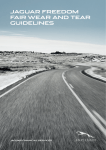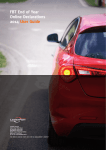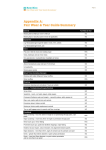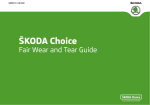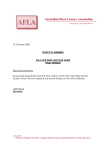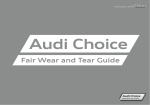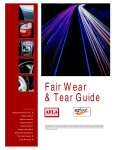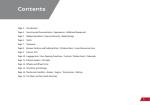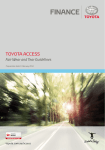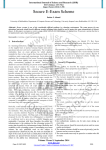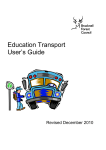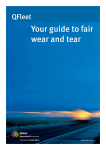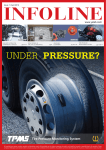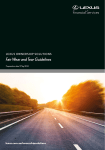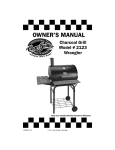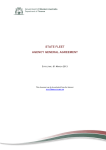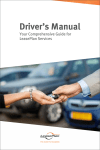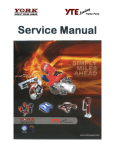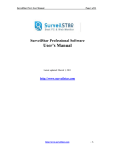Download Fair Wear & Tear Guide.
Transcript
Fair Wear & Tear Guide. Company Alphabet / A division of BMW Australia Finance Ltd. / A.B.N. 78 007 101 715 Australian Credit Licence Number 392387 Postal address P.O. Box 611 / Mulgrave / 3170 Victoria / Australia Office address 783 Springvale Road / Mulgrave / 3170 Victoria / Australia Phone 1800 220 580 Fax +61 3 9561 1876 E-mail [email protected] Internet www.alphabetfleet.com.au Chairman Alan Crookes Managing Director Alan Crookes Finance Director Pascal Orsolle Operations Director Chris Rouskas Fair Wear & Tear What is it? Fair Wear & Tear Guide — The main causes of unreasonable wear and tear in fleet vehicles are: • lack of regular checks by the vehicle user and/or fleet operator, leading to faults and damage going undetected and unrepaired; • not adhering to the vehicle manufacturer’s recommended maintenance and servicing schedule; • drivers not taking responsibility for the day-to-day care and maintenance of the vehicle; • poor quality of body repairs, leading to general neglect; • drivers provided with insufficient information to enable them to responsibly fulfill their obligation to maintain the vehicle. This Guide will hopefully assist in addressing these causes. Questions? 1800 220 580 Taking into account a vehicle’s age and kilometres and covering overall condition, from the mechanics and the electrics through to the bodywork and the upholstery, fair wear and tear summarises the degree of deterioration judged to be reasonable at the end of a contract period. Lack of attention to preventative measures, misuse or neglect are the main reasons fleet vehicles suffer from excessive wear and tear. Fleet operators can expect to incur refurbishment charges from leasing companies if a vehicle is returned with an unreasonable level of wear and tear at the end of a contract period. Where the buck starts - and stops Wear and tear damage may occur through normal, everyday business use, especially for high kilometre fleet vehicles. For example, after a typical fleet lifespan of three years or 100,000 kilometres, stone chips and minor abrasion to a vehicle’s paint work would be deemed fair wear and tear for its age and would not adversely affect the disposal price. If the stone chip damage had exposed the base metal, however, and failure to touch it up had caused penetrating rust to set in, the deterioration would not be acceptable as fair wear and tear. The main question then becomes what is fair and what is not? Responsibility for the monitoring, maintenance and repair of company vehicles will vary from fleet to fleet. The following procedures are recommended to help ensure all the bases are covered: Who Responsibility Fleet Operator’s Responsibility • fleet operators (i.e., lessees) should ensure maintenance and servicing of the vehicle follows the manufacturer’s recommended schedule, using only lessor approved servicing agents and approved quality service parts; • regular spot checks, possibly related to distance travelled and use, should be carried out by the fleet operator to ensure any current problems with care or driver are identified at an early stage; • ensure that a thoroughly completed service book is maintained for the vehicle. User’s Responsibility • note any damage, mechanical problems or areas of worsening wear and tear in the vehicle log book; • a minimum weekly check on oil, water and tyre pressure by the vehicle user. This will also help keep tabs on vehicles which may be losing oil or water or have a slow puncture; • maintain the vehicle custodian log with maintenance schedules; • regularly clean the bodywork, upholstery and trim; • the vehicle should not be used to tow beyond its capacity. Page 2 General Fair Wear & Tear Fair Wear & Tear Guide — Servicing and documentation Regular maintenance and servicing should be carried out by a franchised dealer or lessor approved servicing agent according to the manufacturer’s guidelines, using approved service parts and lubricants only. Any defects or damage that occur during normal vehicle use should be rectified as soon as authority for the repair has been granted. The vehicle instruction book, including the full service record and any other documents relating to vehicle equipment are the responsibility of the vehicle user and must be intact and available. All documents must be in the vehicle on its return to the leasing company - including any details of radio codes. Appearance Regular cleaning of both the interior and exterior of the vehicle is required. The vehicle should be returned at lease end in a suitably clean condition to allow proper inspection of the paint, body and interior. Additional Equipment Accessories such as headphones or DVD remotes that have been installed are to be removed, and any holes or damage should be made good to a professional standard. All standard equipment, together with non-standard or ‘customised’ fittings originally supplied, must be returned at the end of the contract period. Badges and Labels Non-standard badges, labels or advertising fitted to the vehicle interior/exterior or glass of the vehicle should be removed, with any damage caused by their attachment or removal made good. Any paint colour fade due to the attachment of advertising would be chargeable to the user. Advertising should never be painted directly onto the vehicle. Keys and Security A full set of keys should be available along with a note of their numbers. If the locking system is remote, the appropriate key fobs should be available and functioning. Return of the master key which controls the vehicle’s engine management system is mandatory. If the vehicle was originally supplied with a security system, this should be intact and fully operational, including any key or key fob necessary for operation. Any additional, non-standard security system should be fitted according to a recognised standard. Vehicle Exterior Item description Body Damage Dents Paintwork Summary Example Any damage must be repaired as and when it occurs. All work should be completed to a professional standard, with any applicable anti-corrosion guarantees taken into consideration. Obvious evidence of repair such as colour mismatch or mis-alignment between panels is unacceptable. Minor dents (20mm in diameter) are acceptable as long as the paint surface has not been penetrated so that bare metal is visible or corrosion has set in. Multiple dents occuring on a single panel (no matter how small) is unacceptable, and the panel should be repaired or replaced. Small areas of stone chipping, door edge chipping and light scratches (up to 25mm in length) are acceptable, relative to the vehicle’s age and mileage, as long as they have not penetrated through to the base metal and caused corrosion. If stone chippings have penetrated through the metal, suitable touching up should be carried out immediately to prevent further paint deterioration. Exterior paintwork should be free from major abrasions (more than 25mm in length) such as paint damage caused by continual use of automatic car-washing, and have good gloss and colour. Colour mismatch between panels, or poorly fitting panels, are unacceptable. All repairs to the bodywork must be suitably re-rust proofed up to the manufacturer’s recommended standards. Bird excrement should be immediately removed. Bumper Sections and Rubbing Strips Window Glass Lamp Glasses/Lens Provided these are not broken, cracked or deformed a limited amount of scuffing and score marks is acceptable. Cracks or damage within the driver’s sight line are not acceptable and would require windscreen replacement. If relatively minor, repair using resin impregnation to motor registry standards is acceptable. Light scratches and minor chipping around the periphery of the windscreen is accepted as fair wear and tear. The windscreen must be able to pass a roadworthy inspection. All lamps must be operational. Minor scuff marks or scratches are acceptable, but holes or cracks in the glass or plastic covers or lamp units are not. Page 3 Vehicle Interior Item description Interior Trim Luggage Area Summary Surface scoring and light blemishes that reflect normal use are acceptable, but floor coverings and surrounding trim panels should not be torn or split. For light commercial vehicles it is recommended that a lining be fitted in the load area to prevent serious damage to the vehicle’s interior, as excessive damage to this area is unacceptable. Door Opening Tread Area A reasonable amount of scuffing to the door and luggage area treads and sills is acceptable providing paintwork has not been damaged down to bare metal and aperture seals are not torn. Rubber Seals Example The interior should be clean and tidy with no visible burns, tears or permanent staining to the seats, headlining or carpets. Wear and soiling through normal use is acceptable, as are any repairs that are not readily visible. Stitching that has come apart is unacceptable and needs to be repaired. Light Commercial Vehicles Controls Fair Wear & Tear Guide — All original controls must be intact and operate correctly. If replacement has been necessary, e.g. due to theft, then equipment of a similar value and specification, preferably of the same manufacture as the original, should be fitted. All odometer alterations must be reported and unauthorised odometer changes are unacceptable. Information stored in GPS/Satellite Navigation Systems should be deleted. Missing parts and items will be recharged. Normal wear will cause a certain amount of damage and splits to rubber door and other seals, but any evidence of neglect or misuse is unacceptable. If a seal becomes displaced it should be refitted immediately to avoid it becoming trapped or torn. Vehicle Underside Item description Summary Underside Minor dents and deformation, such as stone damage, is acceptable as long as it has not caused major corrosion. Any suspected impact damage should be investigated and dealt with professionally, as significant damage or distortion to chassis components is not acceptable. Example The system should be properly suspended and in efficient working order, with no gas leaks or evidence of blowing from the exhaust system joints and in undamaged condition. Exhaust System The exhaust system should be in a condition to meet motor registry requirements in all aspects, particularly if fitted with a catalytic converter. (CAT) failure is unacceptable and preventable through: • using the correct fuel; • regular servicing and maintenance; • immediately investigating any poor running symptoms; • not tow or clutch starting (for manual transmission) of the vehicle. Oil Leaks Any serious oil leakage should be rectified at the earliest opportunity. Some minor oil misting or dampness around seals or gaskets is acceptable, providing oil drips are not present. Wheels and Wheel Trims Dents or damage to the rim or main body of the wheels are not acceptable. All four wheel trims must be intact, with no more than minor scuffing due to everyday use. If mudflaps are standard equipment they must be intact and properly attached. The spare wheel, jack and appropriate wheel tools must be stowed properly and in good working order. Tyre Wear and Damage All tyres, including the spare, must meet motor registry requirements and comply with the vehicle manufacturer’s recommendations of tyre type, size and speed rating. There should be no obvious damage to sidewalls or tread caused by ‘kerbing’ or other heavy misuse. Page 4 Mechanical Condition Fair Wear & Tear Guide — Regular servicing and maintenance through a lessor approved repairer and in accordance with the vehicle manufacturer’s servicing programmes should keep the vehicle in sound mechanical condition. The following examples are conditions usually caused by vehicle neglect or misuse and therefore are not regarded as fair wear and tear. • Grooves in brake disks caused by metal to metal contact. • Engine seized due to running vehicle with insufficient coolant, lubricating oil and with broken internal components. • Transmission slipping, erratic gear changing, clutch slipping, noisy transmission or ineffective synchromesh. The Road Forward All fleet vehicle users should be aware of the principle of fair wear and tear, along with fleet operators and supervisors. On the vehicle’s return, it is to be inspected and formal agreement documents signed. In instances of disputes an independent assessment should be made. In brief • Fair wear and tear summarises the degree of deterioration judged to be reasonable when a fleet vehicle is returned at end of a contract period; • Lack of attention to detail, misuse or neglect are the main reasons fleet vehicles suffer from unreasonable levels of wear and tear. Some amount of wear and tear damage may occur through normal everyday business use which could be deemed acceptable if reflective of the vehicle’s age, mileage, and overall condition; • All parties should be aware of their responsibilities where monitoring, maintenance and repair of company vehicles is concerned - this will differ from fleet to fleet; • When repairs are carried out long term guarantees should be sought to avoid future problems; • Maintenance and servicing should follow the manufacturer’s recommended schedule and be carried out by approved servicing agents; • Regular spot checks by fleet operators or local supervisors will help ensure any problems with the vehicle (or driver) are identified at an early stage; • A vehicle log book system will help both drivers and fleet operators keep track of any vehicle damage, problems or areas of worsening wear and tear; • The vehicle user should be responsible for a minimum weekly check on oil, water and tyre pressure; • A schedule of regular cleaning and valeting should be worked out between the vehicle user and fleet operator/ supervisor; • All documents must be intact and in the vehicle on its return to the leasing company. Book a return pre-inspection through Manheim. Just ask us how, 1800 220 580 Page 5 Fair Wear & Tear Guide Summary Fair Wear & Tear Guide — These descriptions relate to passenger vehicles having travelled less than 100,000 kilometres. Wear and tear commensurate with higher kilometres, commercial and heavy duty usage will generally apply. Fair Wear & Tear Fair Wear & Tear General Paint/Body (continued) • Missing Service Manual, Owner’s Manual No • Minor touch ups or minor flaking Yes • Missing keys or security system remote (if applicable) No • Prominent touchups, spoils from bird/tree droppings, major flaking No Equipment • e.g. Missing/damaged cigarette lighter, knobs, trims, aerials No • Evidence of poor repairs, colour mismatch, mis-alignment between panels No • e.g. Missing/damaged tools, jack No • Major abrasions - more than 25mm, signs of constant use of automatic car wash No • Dents - greater than 20mm diameter or paint surface penetration No • Dents - less than 20mm diameter, no paint surface penetration and no more than 2 per panel Yes • Information stored in GPS/Satellite Navigation systems should be deleted Glass • 1 or 2 minor chips, bullseyes and stars (not in field of vision) Yes • Major chips, bullseyes and stars (and minor chips in field of vision) • Hail damage, buckling, distortion, missing badges No No Yes • Non-operational or cracked/broken headlights or lenses • Minor stone chipping on bonnet, lower doors, wheel guards No • Prominent areas of major stone chipping No • Un-repaired or poorly repaired aerial holes (or aerial must be left in place) No • Damage caused to the vehicle due to the attachment or removal of decals/stickers No • Damage to paintwork from bird and bat droppings No Tyres • Unroadworthy No • Missing spare tyre No Wheel Trims (including hubcaps) • Missing, split, badly disfigured, heavy scuffing No • Minor scuffing Yes Interior - trim/upholstery/carpets/controls Mouldings/Grille/Bumpers/Mudflaps • Minor parking damage - scuffing, light scratches Yes No • Screw holes from car phone removal No • Medium damage - divots, gouging, minor dents, cracks • Seats/trim - burnt, cut, holed, ripped, visible repairs No • Major damage - rips, major dents, distortions, holes No • Soiling to seats and carpets - caused by normal use Yes • Permanent soiling to seats and carpets - caused by abuse, spills, grease, etc No No • Missing moulds, grilles, bumpers or mudflaps originally fitted to the vehicles • Rips, cuts, marks, splits to trim and controls No • Minor dents and deformations Yes • Normal odours, tobacco smells Yes • Major impact damage No • Missing or inferior quality replacement controls No • Torn or split luggage area trim panels and floor coverings No No • Exhaust leaks which are the result of visible damage to the exhaust system Paint/Body • Minor scratching - less than 25mm in length and shallow, 2 per panel Yes • Major scratching - more than 25mm in length and deep, more than 2 per panel No Underbody Mechanical Condition • Failure to service and maintain the vehicle as per the manufacturer’s recommendations, resulting in premature component or assembly failure (e.g. engine seizure, metal to metal brakes, transmission failure) No Page 6 Vehicle return / exchange checklist Fair Wear & Tear Guide — We’ve compiled a checklist to help ensure that the return and / or exchange of your vehicle goes as smoothly as possible. Please ensure that you have informed Alphabet that you are returning the vehicle and have booked an appointment for the handover. If you are yet to do this, please contact Alphabet on 1800 220 580 who will be happy to assist. Check that none of the following vehicle components and accessories are missing. All keys All vehicle paperwork (completed service history and instruction manual) Vehicle keycard * Radio keycard * Remote control for parking heater * Mobile phone interface * CD changer magazine * Satellite navigation system DVD * Complete toolkit Warning triangle and first-aid kit Luggage safety net and load cover * Wind deflector and protective cover * Tow bar with all keys and tow ball * Spare wheel * Puncture repair kit * Floor mats Complete set of summer tyres with original wheels and matching wheel nuts / locking wheel nuts* Check that all the following criteria are met. Is the car roadworthy and in full working order? Is there sufficient fuel in the tank (minimum range 80 km)? Is the oil level sufficient? Is the tread depth of the vehicle’s tyres still at least 2.0 mm? Has all insurable damage been documented and reported to Alphabet? Have all necessary services and repair work been carried out? Have all services and maintenance work been recorded in the service history? Is the vehicle and its interior clean? Is the vehicle free of visual and technical defects? Have all personal belongings (including high-visibility vests) been removed from the vehicle? Has all damage to windows (e. g. stone chips in the windscreen) been repaired by Alphabet? For a list of approved workshops, visit our wesite at alphabet.com.au * Applies only to certain vehicles and equipment levels. n If the vehicle return occurs under difficult circumstances (darkness, car park, snow / ice, rain or dirt), it may not be possible to record all of the vehicle’s defects in the returns log. Should this be the case, we’ll invoice you for any loss of value in line with the vehicle condition report. n Please ensure that any glass damage is repaired before returning the vehicle. Insurance companies will not accept any fictitious expenses claims set out, for instance, by the vehicle condition report. It is therefore mandatory to submit an invoice for repairs. Glass repairs cannot be carried out at Alphabet authorised dealerships. n We’ll invoice you for any missing parts in line with the vehicle condition report. It’s not possible to send them to us afterwards. n Please note that we must invoice you for any call-outs made by the logistics company where return of the vehicle could not be accepted. Tips to ensure a successful handover: n If you cannot find the service history, please bring the most recent invoice for servicing, repairs or other work on the vehicle with you when returning it. We will not be able to accept the return of vehicles in the following circumstances: n The original wheels and / or summer tyres are missing. The AUSTRALIAN FLEET LESSORS ASSOCIATION (AFLA) is the association of the fleet leasing industry in Australia. ABN 78 059 998 533 GPO Box 1595, Sydney NSW 2001 Phone: (02) 9232 1238 This Guide is published containing information of Association Members and Fleet lessors in Australia, as a statement of the interpretation of “Fair Wear & Tear” in motor vehicle leasing arrangements. The parties may agree to be bound by this Guide, unless other arrangements are made. Nothing in this Guide is intended to limit the right of any party to leasing arrangements to adapt, modify or vary their responsibilities or rights in respect of Fair, Wear & Tear by agreement. © Australian Fleet Lessors Association, Inc. 2005 Page 7







